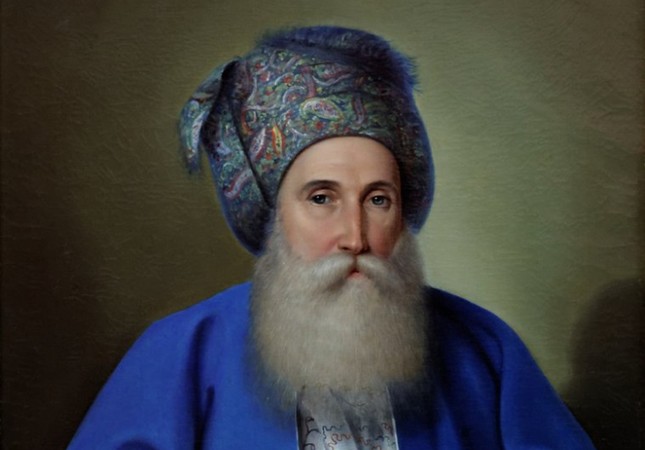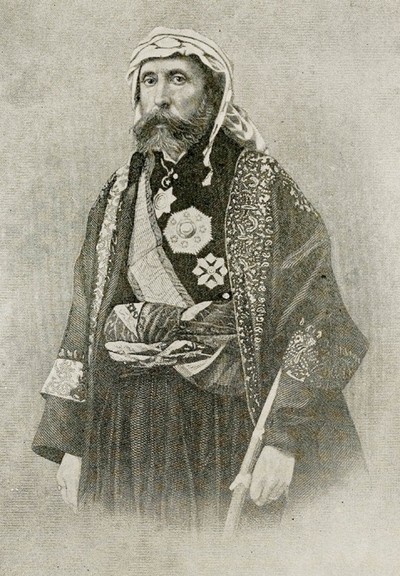.jpg)
AUTONOMOUS OTTOMAN PROVINCES
The administrations of every single province in the Ottoman Empire differed in their features, which allowed the large, contiguous empire that was home to people of various origins and religions to sustain itself for centuries

Grigorie Brancoveanu (1764 – 1832), the voivode of Moldova
The Ottoman Empire was a centralist empire like its peers in the Middle Ages. An empire can be described as a community of states consisting of people with different origins, religions and sects or of various small states gathered around a monarch.
In empires, centralism is not a strictly followed policy. However, comparing an empire to a federal state is also not apt. In an age where human and animal power was used for transportation and communication, empires consisted of financially autonomous agents with few unspecialized bureaucratic staff.
The system
The Ottoman Empire consisted of provinces (eyalet), the provinces consisted of districts (sancak) and the districts consisted of administrative districts (qada). Governors were both the diplomatic ruler and military commander of the provinces and districts. Qadis were judges, political rulers and the mayors of the administrative districts. There were also qadis in addition to the governors in provinces and districts. They were both busy with judicial cases and served as mayor. Both governors and qadis were paid officers appointed by the center.
This system was constructed on the strict contact between administrative, financial and military agents. Hence, income from the territories, which was gained through war and so passed into the hands of the empire, was collected by officers called "sipahi" (cavalrymen) who served under the governor. This income was used to feed the soldiers of the empire.
The Ottoman Empire also had provinces, which were governed on their own, separately from the administrative hierarchy. By accepting Ottoman patronage, these provinces were autonomous in their internal affairs to an extent. They paid a specific tax to the center and also sent troops for military campaigns. These provinces were called "mumtaz eyalat" (privileged provinces).
Autonomy
Following their conquest, the Ottoman Empire bestowed some states with autonomy due to a set of political, historical, financial, religious and social reasons. The Ottomans, however, preferred leaving the former dynasties in charge in most of these states. Dubrovnik, which accepted Ottoman patronage in the 14th century, was the first autonomous province of the Ottoman Empire.
In some of these provinces, there were nearly no Muslim communities. As the empire's small population was taken into consideration, it was clear that it was impossible to construct new settlements in these territories. Partly because of this, the empire granted privileges to these provinces.
This method, similar to the Roman Empire, was applied by the very first periods of Islamic history. Eilat, Oman and Najran in the time of Prophet Muhammad; Tihama in the time of Caliph Umar, Nubia in the time of Caliph Uthman and Armenia in the time of Caliph Muawiyah, were autonomous provinces.
Not all the same
The administrative features of the autonomous provinces were not the same due to historical and political reasons. Some of these provinces, such as Moldavia and Wallachia, were ruled similar to ordinary Ottoman provinces and their administrators were appointed by the center, while others, such as Dubrovnik, had quite weak connections to the center and decided on their administration themselves.
In some provinces like Crimea, administrators were descended from a specific dynasty. Although some of these provinces selected their ruler autonomously, the appointment of administrators was confirmed by Constantinople. All of them had to pay tax to the center and send troops for war.
Territories such as Bohemia, Poland, Moscow, Oman, Aceh, Kashgar, Gujarat, Morocco and Bornu were not in the empire. All the relationships with these states were conducted within the frame of political and military alliances.
In the Byzantine Empire, the early periods of the Ottoman Empire and during the Rumelia expeditions Serbia, Bosnia, Herzegovina, Montenegro and Bulgaria sent tax and soldiers to the Ottoman Empire. After a short while, all of them were annexed into the empire as ordinary provinces.
Best administration
As the Ottoman Empire started to lose power, some autonomous provinces such as Crimea and Aerdeal broke away. Since the time of Sultan Mahmud II, who had to deal with fortifying the central administration and protecting the remaining provinces, the autonomous status of some provinces such as Kurdistan was abolished. These provinces were turned into ordinary provinces, and the status of others such as Romania, Libya and Hejaz were narrowed.
On the other hand, autonomous status was granted to older provinces such as Bulgaria and Serbia, which were undergoing nationalist upheavals, and to some problematic provinces such as Lebanon and Egypt in order not to lose them totally. Hence, the empire continued to have autonomous provinces until the empire fell.

Davut Pasha, of Armenian descent, was the governor of Lebanon in the 19th century.
Decentralization allowed for easier administration for the empire, which was spread across a large area with societies with different origins and religions. Autonomous provinces continued their subordination to the center for a long time due to this method.
British diplomat Sir Charles Eliot, who was in Constantinople between the years of 1893 and 1898, mentions the old system in his memoirs as such, "The old system was better. It was beyond doubt that the governors were strict, however, at least they were better in acting for the good of the locals."
Autonomous provinces of the Ottoman Empire
1. Dubrovnik, 1365-1815 2. Agion Oros, 1374-1913 3. Istanbul (Constantinople), 1453-1909 4. Moldavia and Wallachia (Romania), 1462-1878 5. Montenegro, 1478-1878 6. Crimea, 1475-1774 7. Kurdistan, 1514-1849 8. Hejaz, 1517-1918 9. Arab Emirates, 1517-1918 10. Gallipoli and Aegean Islands, 1533-1876 11. Naxos, 1537-1830 12. Aerdeal (Transylvania), 1541-1699 13. Georgia, 1555-1614 14. Dagestan, 1578-1606 15. Tunisia, 1591-1881 16. Libya, 1603-1912 17. Algeria, 1681-1830 18. Septinsular Republic (Greece), 1800-1863 19. Egypt, 1805-1914 20. Serbia, 1812-1878 21. Greece, 1829-1830 22. Samos, 1832-1913
Önceki Yazılar
-
IF SULTAN MEHMED II HE HAD CONQUERED ROME…17.12.2025
-
VIENNA NEVER FORGOT THE TURKS10.12.2025
-
THE FIRST UNIVERSITY IN THE WORLD WAS FOUNDED BY MUSLIMS3.12.2025
-
WHO BETRAYED PROPHET ISA (JESUS)?26.11.2025
-
IT HAS BEEN MORE THAN 100 YEARS SINCE ITS ABOLITION, BUT... IS THE CALIPHATE BEING REESTABLISHED?19.11.2025
-
GREETINGS TO YOU, O OTTOMAN SANJAK!…12.11.2025
-
ROTHSCHILDS BROUGHT THE END OF THE OTTOMAN EMPIRE!5.11.2025
-
SHEIKH BEDREDDIN, SON OF THE QADI OF SIMAVNA29.10.2025
-
THE ROOTS OF THE ENGLISH POLITICIAN IN TURKEY – THE TRAGIC END OF ALI KEMAL BEY22.10.2025
-
WHERE IS THE RED APPLE?15.10.2025